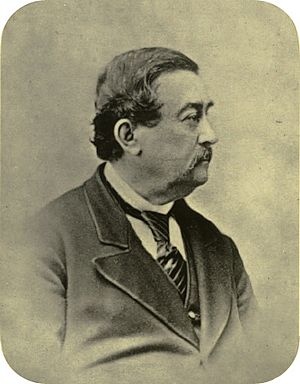Samuel Tickell facts for kids
Colonel Samuel Richard Tickell (born August 19, 1811 – died April 20, 1875) was a British army officer. He was also a talented artist, a language expert, and someone who studied birds. He lived and worked in India and Burma for many years.
Contents
Samuel Tickell's Life Story
Samuel Tickell was born in Cuttack, India. His father was Captain Samuel Tickell, who was also in the army. Samuel went to school in England. From 1827 to 1829, he trained at a military school called Addiscombe.
When he was 19, Samuel returned to India. In 1829, he joined the Bengal Native Infantry, which was part of the British army in India. He served in the 31st Bengal Native Infantry during the Kol campaign from 1832 to 1833. Later, in 1834, he led the military escort for Brian Houghton Hodgson to Kathmandu.
Samuel came back to Bengal in 1843. He became a captain in 1847 and moved to Arakan, which is in lower Burma. He tried working as a land surveyor, but he didn't have much experience. So, he let his assistants do most of the survey work while he managed things. The survey had many mistakes, and in 1849, he left that job and went back to Arakan.
Studying Nature in India
While living in India, Samuel Tickell made important discoveries about birds and mammals. He spent time observing animals in nature and collecting specimens. He wrote about his findings in a science journal called the Journal of the Asiatic Society of Bengal. He sometimes used pen names like "Ornithognomon" or "Old Log" for his writings.
Samuel married Maria Georgiana Templer on July 11, 1844, in Bankura.
Retirement and Later Years
Samuel Tickell retired from the army in 1865. He lived in France for a while before moving to the Channel Islands. In 1870, he was fishing in Brittany and got an eye infection. This infection sadly made him blind over time.
Before he lost his sight, Samuel was working on a huge project. It was a seven-volume set of books called Illustrations of Indian Ornithology. This work was about birds in India. Because of his failing eyesight, he could not finish it. Before he died, he gave his unfinished work to the Zoological Society of London.
These works were later put into fourteen volumes. They included:
- A book about fish found in the seas and freshwaters of British Burma. It had beautiful watercolor pictures.
- A book about mammals.
- A book about insects, reptiles, amphibians, spiders, and crabs.
- Many volumes about birds. These bird books were called Indian Ornithology. They described 488 species of birds and included pictures of 276 of them.
His work showed how talented he was as an artist. He painted birds in their natural homes. He also drew small ink pictures showing scenes from daily life in India.
Samuel Tickell passed away in Cheltenham.
Birds Named After Samuel Tickell
Several birds were named in honor of Samuel Tickell because of his important work. These include:
- Tickell's flowerpecker, known scientifically as Dicaeum erythrorhynchos
- Tickell's leaf warbler, known scientifically as Phylloscopus affinis
- Tickell's thrush, known scientifically as Turdus unicolor
- Tickell's brown hornbill, known scientifically as Anorrhinus tickelli
There is also a bird that might have been named after his wife, or perhaps both of them:
- Tickell's blue flycatcher, known scientifically as Cyornis tickelliae. The name uses a form that could mean it honors a woman or a couple.
Other Interests
Samuel Tickell was also interested in languages. He wrote several articles about the grammar of the Ho language, which is spoken by people in India.


